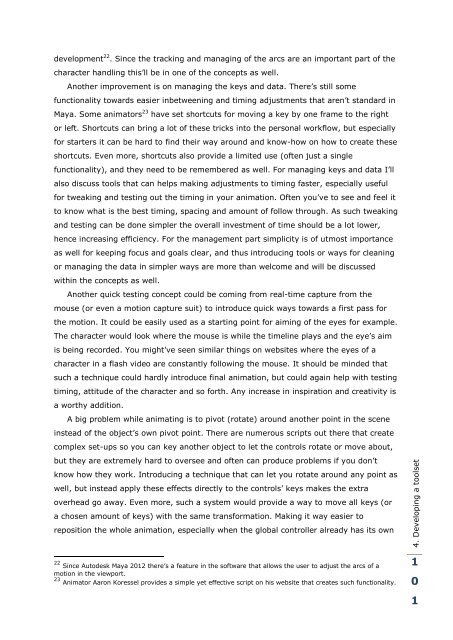Release. Pressure. Animate.
Release. Pressure. Animate.
Release. Pressure. Animate.
You also want an ePaper? Increase the reach of your titles
YUMPU automatically turns print PDFs into web optimized ePapers that Google loves.
development 22 . Since the tracking and managing of the arcs are an important part of the<br />
character handling this‟ll be in one of the concepts as well.<br />
Another improvement is on managing the keys and data. There‟s still some<br />
functionality towards easier inbetweening and timing adjustments that aren‟t standard in<br />
Maya. Some animators 23 have set shortcuts for moving a key by one frame to the right<br />
or left. Shortcuts can bring a lot of these tricks into the personal workflow, but especially<br />
for starters it can be hard to find their way around and know-how on how to create these<br />
shortcuts. Even more, shortcuts also provide a limited use (often just a single<br />
functionality), and they need to be remembered as well. For managing keys and data I‟ll<br />
also discuss tools that can helps making adjustments to timing faster, especially useful<br />
for tweaking and testing out the timing in your animation. Often you‟ve to see and feel it<br />
to know what is the best timing, spacing and amount of follow through. As such tweaking<br />
and testing can be done simpler the overall investment of time should be a lot lower,<br />
hence increasing efficiency. For the management part simplicity is of utmost importance<br />
as well for keeping focus and goals clear, and thus introducing tools or ways for cleaning<br />
or managing the data in simpler ways are more than welcome and will be discussed<br />
within the concepts as well.<br />
Another quick testing concept could be coming from real-time capture from the<br />
mouse (or even a motion capture suit) to introduce quick ways towards a first pass for<br />
the motion. It could be easily used as a starting point for aiming of the eyes for example.<br />
The character would look where the mouse is while the timeline plays and the eye‟s aim<br />
is being recorded. You might‟ve seen similar things on websites where the eyes of a<br />
character in a flash video are constantly following the mouse. It should be minded that<br />
such a technique could hardly introduce final animation, but could again help with testing<br />
timing, attitude of the character and so forth. Any increase in inspiration and creativity is<br />
a worthy addition.<br />
A big problem while animating is to pivot (rotate) around another point in the scene<br />
instead of the object‟s own pivot point. There are numerous scripts out there that create<br />
complex set-ups so you can key another object to let the controls rotate or move about,<br />
but they are extremely hard to oversee and often can produce problems if you don‟t<br />
know how they work. Introducing a technique that can let you rotate around any point as<br />
well, but instead apply these effects directly to the controls‟ keys makes the extra<br />
overhead go away. Even more, such a system would provide a way to move all keys (or<br />
a chosen amount of keys) with the same transformation. Making it way easier to<br />
reposition the whole animation, especially when the global controller already has its own<br />
22<br />
Since Autodesk Maya 2012 there‟s a feature in the software that allows the user to adjust the arcs of a<br />
motion in the viewport.<br />
23<br />
Animator Aaron Koressel provides a simple yet effective script on his website that creates such functionality.<br />
4. Developing a toolset<br />
1<br />
0<br />
1


